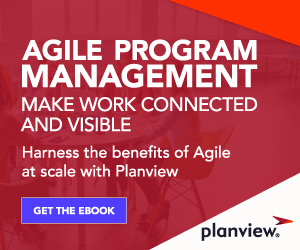
There’s a growing interest to incorporate Scaled Agile Delivery principles across the organisation. Companies are learning how lean and agile delivery methods are impacting visibility, strategic alignment, funding, and accountability. It’s a new way of working—one that comes with challenges to overcome, but worth the effort as it can positively influence strategic agility.
In the webcast, “Scaling Agile within Your Organisation,” industry experts explain more about how organisations can scale agile delivery by connecting lean and agile delivery teams with lean portfolio management.
Scaled Agile Delivery is Trending
According to Forrester Research, agile adoption is increasing, noting an increase in organisations incorporating Scaled Agile Delivery from 22% in 2013 to 50% in 2017.
According to the Harvard Business Review article “Agile at Scale” companies are launching dozens, hundreds, and even thousands of agile teams throughout their organisations. Why? Agile leads to more innovation in comparison to other methods. Teams react to change faster, have faster responsiveness to customer requirements, and have better efficiency and productivity.
A recent Gartner study illustrated that the proportion of an organisation’s work was done, or will be done, by using a product-centric model for software delivery.
In 2016, 21% of respondents used a product-centric model for software delivery, but it’s projected that in 2020 that number will increase to 66%.
The Challenge of Incorporating Agile Principles
Companies taking on the scaled agile delivery transformation are asking, “How do you connect structured, controlled project portfolio management (PPM) with the distributed nature of agile execution?” The challenge of incorporating agile principles, which conflicts with traditional PPM governance, will likely produce many difficult conversations. But traditional portfolio management that involves top-down priorities and approvals is no longer sustainable or scalable.
An agile model is about incremental delivery, autonomy, and teams that work by figuring things out along the way, without the stage gates and structure that traditional methods follow.
Frameworks
There’s been a rising interest in agile frameworks, and there are many available options to choose from: Scrum, Spotify, Less, Scaled Agile, Market Guide for Enterprise Agile Frameworks, to name a few. SAFe (Scaled Agile Framework), however, is gaining the most market share according to Gartner and Forrester studies and recent conference attendees.
By moving away from the traditional project portfolio management and strict governance with project-based teams, the scaled agile delivery model presents a more comprehensive approach to managing teams. Through this approach, teams are organised and responsible for owning both the creation of new features and the support or maintenance of existing ones. This results in increased quality and greater dependability. This ongoing urgency balances efforts to both prioritise new user stories against product support and maintenance that flows down from organisational priorities.
Shifting to the New Normal
An important point to understand (and a change in thinking) is that organizations no longer need to mandate the tools used by teams to get work done. Executives believe that teams using a number of varying tools (LeanKit, JIRA, TFS, and Microsoft, etc.), must converge to one tool, but this isn’t so. In fact, doing so distracts from how well teams perform. Team autonomy is a core value that facilitates the lean and agile model and serves well to keep teams working cohesively. Stable teams aligned around a product promote a strong focus on continuous improvement. Keeping team members together insures that they will improve their efficiencies. In fact, measuring that improvement is one of the dividends from that team stability.
Getting Started
As companies invest in transitioning into a scaled agile delivery model, remember these notions:
- Scaling agile provides a new, different, and better way to connect portfolio management with agile delivery teams.
- Rethink the PMO’s role and foster a partnership with the Agile CoE.
- Get started. You don’t have to take this transformation global right away. Start with one or two smaller organizations and learn what works best. You don’t have to get it right the first time. Once you know what works, apply that proven formula to other departments.
- Look for the right partner to help you through your agile transformation.
Look for the right software partner that offers the following lean and agile delivery capabilities:
- Provides strategic planning and the beginning of lean portfolio management in terms of roadmapping and capacity planning.
- Provides the assistance with your crossover when you perform mid-range PI planning, dependency management, and the visibility for continuous improvement.
- Provides the delivery at the team level could happen in Planview AgilePlace, JIRA, TFS, or other team delivery solutions.
- Provides flexible and adaptable integration to work with other scaled agile delivery tools, allowing teams to work without disruption and to promote team autonomy, better portfolio alignment, improved collaboration with your stakeholders, the data for continuous improvement, and better cross team dependency management.
Get more important details: watch the full webcast: Scaling Agile within Your Organization, read the whitepaper, Agile PMO: 5 Steps to Driving Agility at Scale, or learn more about Planview’s Lean and Agile Delivery Solution.






